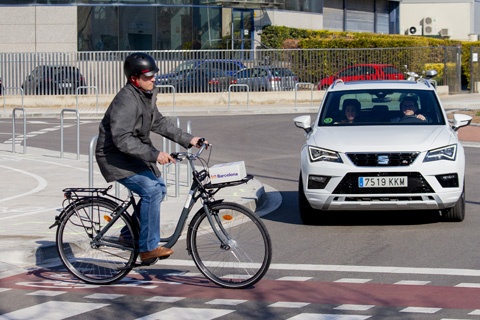At MWC next week, Telefónica and Seat will run a 5G connected car pilot in Barcelona’s streets.
The trial will use C-V2X (Cellular Vehicle to Everything) technology, which enables assisted driving by allowing the vehicle to communicate with all the elements around it, such as cars, traffic lights, traffic signals, pedestrians, cyclists, motorcycles, etc. In addition, 5G and edge computing will be used to deliver the required latency.
As well as providing the end-to-end connectivity, Telefónica will open up its network for the trial so that third parties can deploy applications at the edge, such as traffic management.
Safety use cases
The trial will take place in the L’Hospitalet de Llobregat area and the use cases will include:
- Detection of a pedestrian at a zebra crossing: the traffic lights will detect the presence of pedestrians at zebra crossings through a thermal camera and, via edge computing, will notify the cars. A notice will display on the car control panel.
- Detection of cyclists when turning right: a connected bicycle equipped with a precise geolocation solution will communicate with the cars around it and report their location. In the event of a possible collision, cars will display a warning in the control panel. The bicycles will be detected via ultra-wideband beacons placed along the road.
- Detection of a non-moving car on the road with low visibility: the stationary vehicle in an area of the road with low visibility activates emergency lights and automatically notifies other approaching vehicles with a message in the control panel.
In addition to these safety use cases, Telefónica says this will also be the world’s first 5G in-car entertainment use case, including the download of 4K content. The car is equipped with the new Qualcomm 5G chipset, which, together with the video storage at the edge, allows the streaming of 4K content.
Partners
Telefónica is working with a range of partners for the trial. SEAT contributed with two vehicles – Ateca and Arona models – equipped with the dashboards that issue warnings to the driver.
Ficosa provides the in-car C-V2X communications platform; i2CAT delivers the location solution for the bikes; and ETRA supplies the road infrastructure for connectivity with the traffic light system. Ericsson is providing 5G technology and Qualcomm Technologies is responsible for the 5G connectivity platform – both for the network communication and for direct communication.
The project is part of the 5G Barcelona initiative, aimed at making Barcelona a leading 5G hub in Europe.



